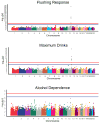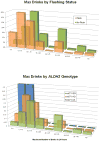ALDH2 is associated to alcohol dependence and is the major genetic determinant of "daily maximum drinks" in a GWAS study of an isolated rural Chinese sample
- PMID: 24277619
- PMCID: PMC4149216
- DOI: 10.1002/ajmg.b.32213
ALDH2 is associated to alcohol dependence and is the major genetic determinant of "daily maximum drinks" in a GWAS study of an isolated rural Chinese sample
Abstract
Alcohol dependence (AD) is a moderately heritable phenotype with a small number of known risk genes mapped via linkage or candidate gene studies. We considered 313 males from among 595 members of documented, extended pedigrees in which AD segregates collected in Northern Hunan Province, China. A joint analysis of both males and females could not be performed as the difference in alcohol consumption variance was too large. Genome-wide association analyses were performed for approximately 300,000 single nucleotide polymorphisms (SNPs). Significant associations found in the ALDH2 region for AD (minimum P = 4.73 × 10(-8)) and two AD-related phenotypes: flushing response (minimum P = 4.75 × 10(-26)) and maximum drinks in a 24-hr period (minimum P = 1.54 × 10(-16)). Association of previous candidate SNP, rs10774610 in CCDC63, was confirmed but resulted from linkage disequilibrium with ALDH2. ALDH2 is strongly associated with flushing response, AD, and maximum drinks in males, with nonsynonymous SNP rs671 explaining 29.2%, 7.9%, and 22.9% of phenotypic variation, respectively, in this sample. When rs671 was considered as a candidate SNP in females, it explained 23.6% of the variation in flushing response, but alcohol consumption rates were too low among females-despite familial enrichment for AD-for an adequate test of association for either AD or maximum drinks. These results support a mediating effect of aldehyde dehydrogenase deficiency on alcohol consumption in males and a secondary, culturally mediated limitation on alcohol consumption by females that should be appropriately modeled in future studies of alcohol consumption in populations where this may be a factor.
Keywords: alcohol dependence; aldehyde dehydrogenase; flushing response; genome-wide association; maximum drinks.
© 2013 Wiley Periodicals, Inc.
Conflict of interest statement
Figures


References
-
- Almasy L, Blangero J. Endophenotypes as quantitative risk factors for psychiatric disease: rationale and study design. Am J Med Genet. 2001;105:42–44. - PubMed
-
- American Psychiatric Association. Diagnostic and Statistical Manual of Mental Disorders, Fourth Edition Revision DSM-IV-R. American Psychiatric Press; Washington, DC: 2000.
-
- Berney A, Preisig M, Matthey M-L, Ferrero F, Fenton BT. Diagnostic interview for genetic studies DIGS: inter-rater and test-retest reliability of alcohol and drug diagnoses. Drug Alcohol Depend. 2002;65:149–158. - PubMed
Publication types
MeSH terms
Substances
Grants and funding
LinkOut - more resources
Full Text Sources
Other Literature Sources
Medical
Miscellaneous

